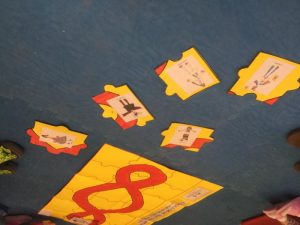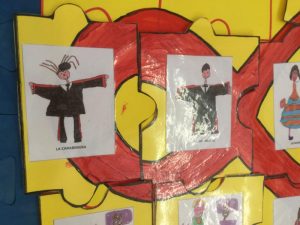“Shall we play the Third Paradise?” is becoming a recurring question among the children from the nursery school “P. Guarneri”, thanks to an initiative the comprehensive institute is carrying out. It is “Il mondo che vorrei” (The world I’d like), a project by the school in Lombardy aiming at investigating in depth themes related to sharing, inter-culture, ethics and inclusion. It is not the first time the local youngest generations find themselves face to face with Michelangelo Pistoletto’s sign-symbol: last December, on the occasion of the Rebirth Day, the pupils from this same institute coloured special flags representing the Third Paradise, also donating one painted by the children to the town of Palazzolo sull’Oglio (please see our previous article). From the rebirth of the last 21st December, the didactic activities on the topic have continued, developing and analysing the meaning of the symbol of the Third Paradise.
But going back to the ludic-educational activity based on the sign-symbol of the artist from Biella: the school has decided to enter the contest announced by FILA called “School at play” and, in this context, has created two games: “The game of equal opportunities – the jigsaw puzzle of the Third Paradise” and “The game of the Third Paradise”, since the objective of the contest – dedicated to nursery and primary schools – is to invent and illustrate an educational game, with the teachers coordinating the choice of the most suitable language to represent an experiential ludic process (the winning school will be awarded with a creative schoolroom).
Let’s go into the specifics of these two new games, starting from finding out the rules, as I child would. In “The game of equal opportunities”, for up to 6 players, each participant in turn identifies a piece of the jigsaw puzzle and places it in the correct position, until the structure is completed. The basic suggestion is to follow the lines of the Third Paradise, deciding where to best place the different elements; after the positioning of the image of a profession you have to find the corresponding piece and place it next to it (see image below). In “The game of the Third Paradise”, for up to 6 players as well, you have to roll a dice as in “Snakes and Ladders”: if you land on the figures marked with two green squares (good actions: e.g. recycling and clean sea) you can move two steps forward; if you land on red squares (negatives like a polluted sea) you have to move backwards; if you land on the Third Paradise you gain the opportunity to throw the dice again, as a wildcard; if you land in the squares representing actions carried out by both boys and girls you have to mime them. The first player to reach the square with the planet Earth wins.


(The game of equal opportunities)
As you might have guessed, the two activities are more than a mere pastime. Analysing “The game of the Third Paradise”, similar to “Snakes and Ladders”, you can clearly see the educational finalities of the game: facilitating the assumption of behaviours attentive and respectful of others, encourage the development of linguistic skills through the listening of a narrative, the reflection and the dialogue; enhancing the expressive creativity; developing and experimenting the languages of communication of moods, feelings and emotions; raising the awareness that all children, independently from the sex, have the same opportunities and can carry out the same activities and games, opposing prejudices and stereotypes linked to gender roles. Focusing on this last issue, we can see the link with “The game of equal opportunities.
In this second activity, in fact, the name precedes the contents of the game: the teachers have faced the issue together with the children, considering the importance to have a sense of respect for all professions from a very early age, in order to preserve one’s own dreams and future perspectives. Starting from the story “Is there anything more boring than being a pink princess?” by Raquel Diaz Reguera, the teachers asked the young pupils to redraw the story of the protagonist, imagining what she would do once a grown up woman. The children then listed all their wishes about their futures and represented the profession they would like to follow. From these drawings they made up cards depicting a few professions, both in male and female versions. These little works led to the idea of a jigsaw puzzle based on the Third Paradise, the symbol best representing an ideal world, where to live without prejudices and stereotypes.
“Besides developing the educational finalities and the objectives suitable to their ages, – explains Alice Franzoni, teacher and referent of the project – the didactic experiences with the children from the nursery school are at the basis of the building of their personalities. If you learn having fun, it is very unlikely that you forget what you have learned. According to Bruno Munari, artist and designer particularly engaged in the development of creativity and imagination, children take playing as a very serious activity. We teachers have found extremely useful and interesting to refer to the philosophy of the Third Paradise, inasmuch as it constitutes a valid input for the activities spanning across the themes of inter-culture, inclusion, respect for the others and for the environment. We also believe that the school should be open to the territory and stimulate reflections involving the families and the local community. Art (and in our case the symbol conceived by Michelangelo Pistoletto) can be a means to promote a better world.”
(Didascalia foto di copertina: Il gioco del Terzo Paradiso)

